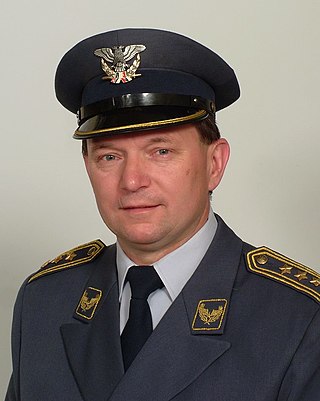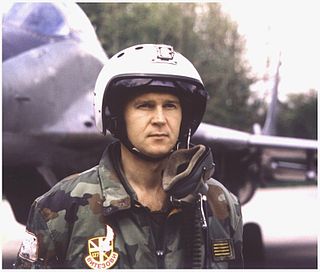
The Mikoyan-Gurevich MiG-21 is a supersonic jet fighter and interceptor aircraft, designed by the Mikoyan-Gurevich Design Bureau in the Soviet Union. Its nicknames include: "Balalaika", because its planform resembles the stringed musical instrument of the same name; "Ołówek", Polish for "pencil", due to the shape of its fuselage, and "Én Bạc", meaning "silver swallow", in Vietnamese.

The Mikoyan-Gurevich MiG-15 is a jet fighter aircraft developed by Mikoyan-Gurevich for the Soviet Union. The MiG-15 was one of the first successful jet fighters to incorporate swept wings to achieve high transonic speeds. In aerial combat during the Korean War, it outclassed straight-winged jet day fighters, which were largely relegated to ground-attack roles. In response to the MiG-15's appearance and in order to counter it, the United States Air Force rushed the North American F-86 Sabre to Korea.

The Mikoyan MiG-29 is a twin-engine fighter aircraft designed in the Soviet Union. Developed by the Mikoyan design bureau as an air superiority fighter during the 1970s, the MiG-29, along with the larger Sukhoi Su-27, was developed to counter U.S. fighters such as the McDonnell Douglas F-15 Eagle and the General Dynamics F-16 Fighting Falcon. The MiG-29 entered service with the Soviet Air Forces in 1983.

The North Atlantic Treaty Organization (NATO) carried out an aerial bombing campaign against the Federal Republic of Yugoslavia during the Kosovo War. The air strikes lasted from 24 March 1999 to 10 June 1999. The bombings continued until an agreement was reached that led to the withdrawal of the Yugoslav Army from Kosovo, and the establishment of the United Nations Interim Administration Mission in Kosovo, a UN peacekeeping mission in Kosovo. The official NATO operation code name was Operation Allied Force whereas the United States called it Operation Noble Anvil ; in Yugoslavia the operation was incorrectly called Merciful Angel, possibly as a result of a misunderstanding or mistranslation.
This is a list of aviation-related events from 1999.

The Serbian Air Force and Air Defence, is the air force of Serbia and service branch of the Serbian Armed Forces. Its mission is to guard and protect the sovereignty of Serbian airspace, and jointly with the Serbian Army, to protect territorial integrity of the country.

Zoltán Dani is a Serbian Hungarian retired officer of the Yugoslav Army.

The Banja Luka incident was an air-to-air action that took place over Bosnia on 28 February 1994 when six Republika Srpska Air Force J-21 Jastreb single-seat light attack jets were engaged, and five of them shot down or crashed during escape, by NATO warplanes from the United States Air Force. In response to an attack on a Bosnian weapons factory, U.S. F-16 fighters operating southwest of Banja Luka successfully intercepted and destroyed the Bosnian Serb warplanes. The engagement resulted in no U.S. casualties. It marked the first active combat action, air-to-air or otherwise, in NATO's history.

The Air Force of Serbia and Montenegro, also known as the Air Force of Yugoslavia from 1992 to 2003, was the air force of the former Serbia and Montenegro. It had around 300 fighter aircraft, ground attack aircraft, and other aircraft. The air force, in 1998, had about 16,000 personnel. The air force was disbanded when Montenegro voted to secede from the ex-FRY in 2006. The bulk of it was inherited by the Serbian Air Force and Air Defence.
The Leteće zvezde was the official aerobatic flight display team of the Yugoslav Air Force.

The 252nd Training Squadron "Ušće Wolves" is a squadron of the 204th Air Brigade of the Serbian Air Force and based at Batajnica Air Base.
The General Dynamics F-16 Fighting Falcon has served the United States and the air arms of 25 other nations. Over 4,400 F-16s have been sold.
During the 1991 Gulf War and subsequent operations in no-fly zones over Iraq, Coalition air forces faced the Iraqi Air Force (IQAF), the fourth largest air force in the world at the time. In the opening days of the war, many air-to-air engagements occurred, between Iraqi interceptors and a variety of different Coalition aircraft.
Cesar Antonio Rodriguez is a former United States Air Force (USAF) officer and pilot who served from 1981 to 2006. With three air-to-air combat victories, he joined USAF pilots Thomas Dietz, Robert Hehemann and Robert Wright as the closest to becoming a flying ace of any U.S. pilot since the Vietnam War. Rodriguez scored his kills in an F-15 Eagle - the first two kills in 1991, during the first Gulf War, against a Mikoyan MiG-29 and a Mikoyan MiG-23 of the Iraqi Air Force, and his third kill came against a MiG-29 of the Yugoslav air force during the 1999 NATO bombing of Yugoslavia.

On 27 March 1999, during the NATO bombing of Yugoslavia, a Yugoslav Army unit shot down a Lockheed F-117 Nighthawk stealth ground attack aircraft of the United States Air Force by firing a S-125 Neva/Pechora surface-to-air missile. It was the first ever shootdown of a stealth technology airplane. The pilot ejected safely and was rescued by U.S. Air Force Pararescuemen conducting search and rescue.

Milenko Pavlović was a Yugoslav fighter pilot who fought in the Kosovo War and came to prominence after he was killed during the NATO bombing of Yugoslavia.

Zoran Radosavljević was a Yugoslav fighter pilot who fought in the Kosovo War and came to prominence after he was killed during the NATO bombing of Yugoslavia.

The Air Battle of Valjevo was fought on 4 May 1999, between 2 USAF F-16CJs escorting a NATO formation and 1 MiG-29 flown by Milenko Pavlović, commander of the Yugoslav Air Force 204th Fighter Regiment. Pavlović was shot down and killed by a AIM-120 AMRAAM fired by Michael H. Geczy of the 78th Expeditionary Fighter Squadron.












